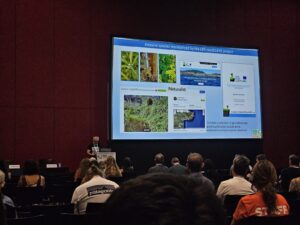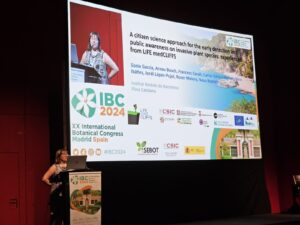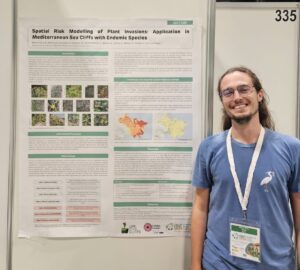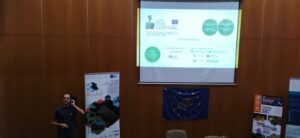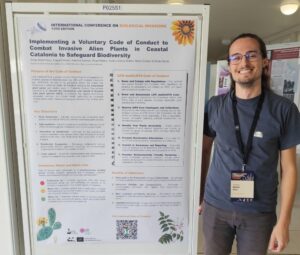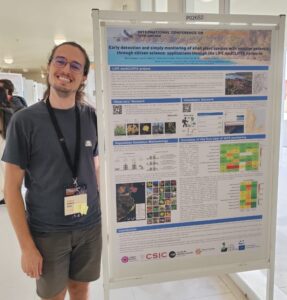
Summer is coming to an end and the LIFE medCLIFFS’ team is back with some news about the presentations we have given in different congresses.
International Botanical Congress (IBC2024)
During the XX International Botanical Congress (IBC2024) in Madrid (21st-27th of July 2024) we gave several talks and presented different posters related to the LIFE project. We discussed about various topics and enrolled in several dialogues with many researchers from Spain, as well as others from all around the world, especially regarding biological invasions. However, one of the most controversial topics in the congress was the debate about the methodology developed by the IUCN named Environmental Impact Classification of Alien Taxa (EICAT). This tool aims to assess, homogeneously, the negative impacts of invasive species, as well as their version to evaluate the positive impacts, EICAT+.
Some researchers considered that opening the door to the study of the positive impacts could involve withdrawing importance to the message and priority of the threat posed by the invasive species on biodiversity (one of the major causes of biodiversity loss according to the Intergovernmental Science-Policy Platform on Biodiversity and Ecosystem Services (IPBES)).
Some researchers sustain that it is crucial to dispose of a standardized tool to assess both the positive and negative impacts. This would let us identify, accurately, the real positive impact. Often this impact is justified by academia and land managers based on very specific cases where only the favourable results to some indicatoers are taken into account, ignoring the complexity of the ecosystems.
An example of this cherrypicking is the cascade effects in a trophic network where one species can develop while others diminish. Another example would be the increase of nutrients in an oligotrophic environment which can be beneficial to one species, but detrimental to all the others. A different approach is the assessement of invasive species counting only on the immediate economic, or environmental, profits disregarding the long-term effects, for instance; one can argument that the introduction of Opuntia is useful for its edible fruits. The fruits can be sold and serve as a food source in arid environments, and they can also be used to control soil erosion in dry regions, thanks to its ability to grow on harsh conditions.
Nevertheless, these reasons disregard all other negative impacts, such as abitat degradation and replacing local plant communities, both affecting the biodiversity. Quite often these negative effects are overlooked in situations where only local benefits are being promoted.
In conclusion, the debate is served and it is clear that studying the impacts on systems as complex as the ecological ones is not an easy task. However, there is a great deal of effort focused on identifying the species with biggest impact, which can be used to priotitize their management. You can read more about it at:
IUCN: https://iucn.org/es/node/33103 (English)
Journal: https://doi.org/10.1371/journal.pbio.3001729 (English)
Downloadable content:
https://portals.iucn.org/library/node/49101 (English)
https://portals.iucn.org/library/node/51391 (Spanish)
During the International Botanical Congress (IBC2024) there were two oral presentations and two posters about the LIFE medCLIFFS project:
Oral – Employing the Environmental Impact Classification for Alien Taxa (EICAT) on coastal areas: the example of the Costa Brava (Spain)
Carlos Gómez-Bellver, Neus Ibáñez, Neus Nualart, Arnau Guiu-Bosch, Jordi López-Pujol
In this presentation, the highlight was on the rising problem of biological invasions on the Mediterranean coasts, especially in the Costa Brava. The zone, with a high richness of native species, and even endemisms, is subjected to anthropocentric pressure due to massive urbanization and tourism. This has facilitated the entrance of invasive plant species, mostly escaped from gardens.
In order to minimize new invasive plant introductions and to improve the management of the ones already present in the Costa Brava, we explained how we were conducting the LIFE medCLIFFS project through citizen science. This part consists of volunteers who adopted a transect of about 0.5-1 km along the coast and they survey the area for the presence and the extension of the 33 invasive, or potentially invasive, species and monitor them using the iNaturalist app. Based on this information the impacts of these 33 species are classified following the Environmental Impact Classification for Alien Taxa (EICAT), a tool created by the IUCN in 2020. This is the first time this tool has ever been used for this classification and for a LIFE project, on coastal areas specifically. We also expect this methodology to help improve the accuracy and comprehension of these impacts on the impacts of invasive species in the future.
.
Oral – A citizen science approach for the early detection and public awareness on invasive plant species: experiences from LIFE medCLIFFS
Sònia Garcia, Arnau Bosch, Francesc Caralt, Carlos Gómez-Bellver, Neus Ibáñez, Jordi López-Pujol, Roser Melero, Neus Nualart
This presentation focused on showing the project, its methodology and the results of the LIFE medCLIFFS so far. Among the results it is important to note that the Observators’ Network, with 109 registered members, until November 2023, have submitted 4.345 observations of 180 invasive, or potentially invasive, species; with Opuntia ficus-indica as the most prevalent species.
At the same time, the Volunteers’ Network, currently has 92 members and is focused on the 33 highly invasive species, the most prevalent species is Pittosporum tobira. The detailed observations are added to a database and used to produce maps and predict the invasion risk according to species and area.
The network is also a useful resource for early detection of new invasive species which have not yet been registered as present in the study area. Moreover, apart from the contribution to the management of these species, these citizen science networks increase public awareness about this problem and contribute to the spread of botanical knowledge; creating a community sensitized to the importance of environmental conservation and management.
Poster – The Costa Brava (coast of NE Spain) as a focus of plant invasions: floristic novelties resulting from the first steps of the LIFE
Carlos Gómez-Bellver, Neus Ibáñez, Neus Nualart, Arnau Bosch-Guiu, Jordi López-Pujol
Regarding the posters, the first one exposed the results from the beginning of the project in 2022 during the field trips to design the transects for the volunteers. We detected a large number of species for the first time on the coast, and some of these were even European novelties (Agave parryi and Heptapleurum arboricola).
Poster – Spatial risk modelling of plant invasions: application in Mediterranean sea cliffs with endemic species
Arnau Bosch-Guiu, Roi Rodríguez-González, Neus Nualart, Carlos Gómez-Bellver, Neus Ibáñez, Sònia García, Roser Melero, Daniel Vitales & Jordi López-Pujol.
In the second poster, Arnau Bosch explained that the spatial risk models are a valuable tool to predict the likelihood of an invasive plant species to spread, establish and persist in a specific environment. This method identifies the priority areas with a higher risk of invasion aiding land managers to make better decisions on prevention, early eradication, or containment interventions. In line with this, one of the objectives of LIFE medCLIFFS involves the application of “Riskmapr”, a tool developed by Froese et al. in 2019, to map the risk of invasion of an alien species, enabling a rapid response against plant invasions.
In the initial phase, the project focused on invasive Opuntia ficus-indica, Carpobrotus spp., and Gazania rigens affecting the Cap de Creus Natural Park and its surrounding areas. The obtained risk maps — employing the “Riskmapr” tool — will be overlaid with the distribution areas of endemic and threatened species (Limonium geronense, L. tremolsii, and Seseli farrenyi) to improve management practices in the natural park.
For more information about the presentations visit the following link: IBC2024 Orals
For more information about the posters visit the following link: IBC2024 Posters
NeoBiota Congress
This summer the project has also participated in the 13th International Conference on Biological Invasions, NeoBiota 2024. We had the opportunity to talk with the team of LIFE INVASAQUA (a project working on invasions in water bodies in the Iberian Peninsula) about the importance of the conservation actions of the projects. They gave us several pieces of advice and we also talked about possible collaborations in the future.
We retook contact with the LIFE COOP Cortaderia (a project that aims to stop the spread of the pampas grass, Cortaderia selloana, in Europe with partners in Spain, Portugal and France), and they were also very interested in our biological control of Opuntia ficus-indica with Dactylopius opuntiae. We also agreed on sharing contacts and institutions responsible for invasive species management in Catalonia with them, for future collaborations.
The Indigena Biosecurity International director, with whom which we discussed methodologies to control invasive species, and the Centre for Agriculture and Bioscience International (CABI), were very interested in the biological control of the Opuntia, and offered us counsel on how to manage Gazania rigens.
Several LIFE project managers and researchers in the environmental biology field showed interest in the IAPS control and eradication tasks in private gardens and the positive response to the control tasks. We could confirm the high level of sensitization of the citizens in Catalonia to the threat posed by the IAPS to our coastal ecosystems. We also received many questions about the volunteer networks which demonstrated to be an excellent example of collaboration between the citizens, science and administration for an efficient, early detection; as were the simplified methodology to study the population dynamics, with the information gathered from the citizen science. The essential role of the Code of Conduct in prevention was also appreciated.
During this congress, there was one oral presentation, about the general aspects of the LIFE medCLIFFS, similar to the one in the IBC2024 and two posters, one about the Code of Conduct and another about the role of citizen science in early detection and prevention.
Oral – LIFE medCLIFFS – Towards an integrative management of Invasive Alien Plant Species in Mediterranean sea cliffs of European interest (LIFE20 NAT/ES/001223)
Arnau Bosch-Guiu
The presented posters were as follows:
Poster – Implementing a voluntary Code of Conduct to combat invasive alien plants in coastal Catalonia to safeguard biodiversity
Arnau Bosch-Guiu, Edgard Mestre, Katherina Karinou, Roser Melero, Carlos Gómez-Bellver, Maria Guirado & Sònia Garcia.
The first poster of the congress was dedicated to the Code of Conduct; a voluntary instrument to prevent the introduction and expansion of the IAPS.
Addressing the threat of Invasive Alien Plant Species (IAPS) requires proactive measures to safeguard biodiversity, human health, and economic vitality. LIFE medCLIFFS aims at fighting against the problem of IAPS in the coastal regions of Catalonia. One of the strategies to fight the problem IAPS problem on the Catalan coast is the Code of Conduct, which encourages the professionals of the ornamental plant sector and users to: (1) know and comply with regulations, (2) learn about and disseminate the project lists of invasive plants, (3) remove invasive species from catalogues and collections, (4) ensure accurate plant identification before their commercialization or use, (5) promotion of non-invasive alternatives, (6) commit to inform, and (7) advocate for environmentally friendly gardening practices. It emphasizes the role of public awareness and engagement in combating the invasive plant menace and calls for collective action towards sustainable biodiversity conservation.
The key components of the Code include a consensus list of highly invasive species, a watch list of species with invasive potential, and a white list of non-invasive alternatives. These lists, developed through consensus among a multisector group of experts (i.e., researchers, gardeners and landscape planners, public administration, public associations, and nurseries), guide plant selection and marketing decisions, aiming to minimize the spread of IAPS. Ultimately, the LIFE medCLIFFS Code of Conduct presents a proactive approach to addressing the challenges posed by IAPS by integrating biodiversity into the market through fostering collaboration, raising awareness, and promoting responsible ecosystem protection.
Poster – Early detection and simply monitoring of alien plant species with invasive potential through citizen science: applications through the LIFE medCLIFFS networks
Neus Nualart, Carlos Santana, Arnau Bosch-Guiu, Carlos Gómez-Bellver, Neus Ibáñez, Francesc Caralt, Sònia Garcia, Jordi López-Pujol.
This poster showed the LIFE project, especially the citizen science role in the project through two networks that leverage iNaturalist: the Observers’ and the Volunteers’ Network.
The Observers’ Network gathers 180 invasive, or potentially invasive, plant species. Until May 2024, 5.500 observations have been registered that feed a database to produce risk maps. This network serves as an early detection tool for new occurrences that have not been registered yet in the study area.
The Volunteers’ Network, focused on the 33 highly invasive species, found in the 1km transects, adopted and managed by the same volunteers, gathered 700 observations by the end of 2023.
This methodology, whose outputs are easily interpretable as heatmaps, allows the collection of large datasets on invasive plants by citizen scientists, with two main applications: identifying which species are most worrisome based on simple, straightforward observations of their population dynamics; and determining which sectors of the study area are more problematic, and thus, where management efforts should be directed.
For more information about the congress follow the link: Neobiota2024 o la pròpia pàgina web https://www.neobiota2024.org/



